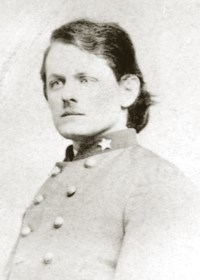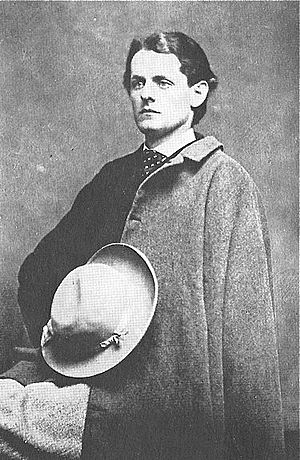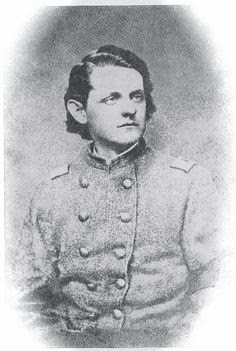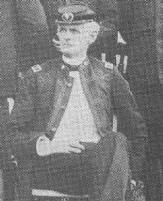Henry Kyd Douglas facts for kids
Henry Kyd Douglas (1838–1903) was an important officer in the Confederate States Army during the American Civil War. He fought in many battles, especially with the Second Corps, Army of Northern Virginia. He worked closely with famous generals like Stonewall Jackson.
Douglas was badly hurt during the Battle of Gettysburg and became a prisoner of war for a long time. Near the end of the war, he led a group of soldiers in the very last battle. After the war, he became a lawyer and was involved in state politics. He also became a high-ranking officer in the Maryland National Guard. Today, Henry Kyd Douglas is best known for his book, I Rode with Stonewall, which tells about his experiences during the war.
Contents
Early Life and Education
Henry Kyd Douglas was born in 1838. His father, Robert Douglas, was a minister from Scotland. Henry grew up on Ferry Hill Place, near Shepherdstown, West Virginia. This home was very close to Harpers Ferry, West Virginia.
When he was young, Douglas saw John Brown's raid on Harpers Ferry. He watched as U.S. Marines ended the raid. He also saw the trial that followed. Douglas went to Franklin & Marshall College in Pennsylvania, graduating in 1858. He then studied law in Lexington, Virginia, and became a lawyer in 1860. When the Civil War began, he returned to Virginia.
Serving in the Civil War
In April 1861, Henry Kyd Douglas joined the army as a private. He was part of the 2nd Virginia Volunteer Infantry Regiment. This group later became known as the Stonewall Brigade. One of his first tasks was to help burn a bridge over the Potomac River. This was a difficult moment for him, as his father owned part of the bridge.
Douglas quickly moved up in rank. He fought at the First Battle of Bull Run as a first sergeant. At the First Battle of Kernstown, he was a lieutenant leading his own company. In 1862, he joined Stonewall Jackson's staff, which was like being on the general's personal team.
Working with Stonewall Jackson
Douglas became an assistant inspector general on Jackson's staff. His job was to make sure orders were carried out correctly. For example, he checked that railroad tracks were completely destroyed when ordered. He also delivered messages and reports during battles. At the Battle of Antietam, he rode so much that he wore out two horses. He even fainted from exhaustion.
Douglas also had some unusual duties. Once, he had to tell General A. P. Hill that he was being removed from command. Another time, a woman named Belle Boyd, whom he knew, gave him important information about enemy forces before the Battle of Front Royal.
In late 1862, Douglas became a captain of his old company, Company B, 2nd Virginia Volunteers. He also continued to serve as assistant inspector general for the Stonewall Brigade. When Stonewall Jackson was wounded at the Battle of Chancellorsville, Douglas visited him. After Jackson's death, Douglas helped escort his body to Richmond, Virginia. He attended the funeral procession, riding in a carriage behind Mrs. Jackson and President Jefferson Davis.
After Jackson's death, Douglas joined General Edward Johnson's staff. He became an assistant adjutant general with the rank of major.
Wounded and Captured
On the third day of the Battle of Gettysburg, Douglas was badly wounded in his left shoulder. His left arm was temporarily paralyzed. He was guiding soldiers into position during an attack on Culp's Hill. He was taken to a nearby farm that was being used as a hospital. His mother and sister traveled through the battle lines to visit him.
After a few days, Douglas was released on parole by a Union officer. This meant he promised not to fight again until he was officially exchanged for a Union prisoner. He was cared for by the Picking family at the farm. Later, he moved to the Gettysburg Theological Seminary, where an old college friend, Henry Leaman, was his doctor.
Douglas stayed in Gettysburg for about a month. Then, he was moved to a hospital in Baltimore. He was still considered a prisoner of war. He tried to get his parole officially recognized, but the Union Army said the officer who gave it didn't have the authority. After a few months, he was transferred to a prison camp for Confederate officers called Johnson's Island. He found the camp very cold, but the food was enough. In February 1864, he was moved to Point Lookout prison camp in Maryland, where he was hospitalized due to illness from the cold.
Return to Service
In March 1864, Douglas was sent home, though he was not formally exchanged yet. He returned to the army on the first day of the Battle of the Wilderness. He served again as assistant adjutant general for General Edward Johnson's division. He fought at the Wilderness and at Battle of Spotsylvania Court House. At Spotsylvania, he managed to escape when his general and many soldiers were captured.
Douglas then served on General John Brown Gordon's staff. Later, he moved to General Jubal Early's division. When Early took command of the Second Corps, Douglas became the assistant adjutant general for that corps.
As the Union Army pushed the Confederates back, General Robert E. Lee sent Early's corps to threaten Washington, D.C.. The hope was that this would make Union General Ulysses S. Grant send his troops away from other battles. Douglas rode near Washington, D.C., and saw Confederate soldiers at Francis P. Blair's home. He chased them away, and the house became Early's headquarters for a night.
Early's attack on Washington did not succeed. His corps returned to the Shenandoah Valley to fight General Philip Sheridan's army. General John B. Gordon took command of the Second Corps in November. Douglas remained his assistant adjutant general. The corps then moved to the trenches of Petersburg, Virginia. They made a difficult attack on Battle of Fort Stedman in March 1865.
Douglas then became the commander of Walker's Brigade, which was a much smaller group of soldiers by then. He led this brigade at the Battle of Sailor's Creek and at the very last battle of the Civil War in Virginia, the Battle of Appomattox Court House, where the Confederates surrendered.
Life After the War
After the war, Douglas faced some challenges. He was held for a short time because he was seen in his Confederate uniform. He was also called as a witness in the investigation after President Abraham Lincoln was assassinated. After being released, he was arrested and discharged several times before finally being set free from Fort Delaware.
Douglas became a successful lawyer, first in Winchester, Virginia, and then in Hagerstown, Maryland. He was known as a good speaker. He ran for Congress in 1886. He was also involved in Maryland politics.
Douglas kept his interest in military matters. In 1876, he became a colonel on Governor Carrol's staff. During a large railway strike in 1877, Douglas commanded Maryland forces in the western part of the state. He later became a captain of a local militia company in Hagerstown. He rose through the ranks in the Maryland National Guard, becoming a lieutenant colonel and then a colonel. From 1892 to 1896, he served as the Adjutant General of Maryland, which is a very high military position in the state.
During the Spanish–American War, he was offered a position as a brigadier general, but he had to decline due to poor health. Henry Kyd Douglas died in Hagerstown in 1903 from tuberculosis.
Douglas always cared about the history of the Civil War. He was a member of a society for Confederate army and navy veterans. During the war, he kept a diary. After the war, he used this diary to write a long memoir, or personal story, about his experiences. This memoir was finally published in 1940 as I Rode with Stonewall, which is still a very popular book about the Civil War.
|





